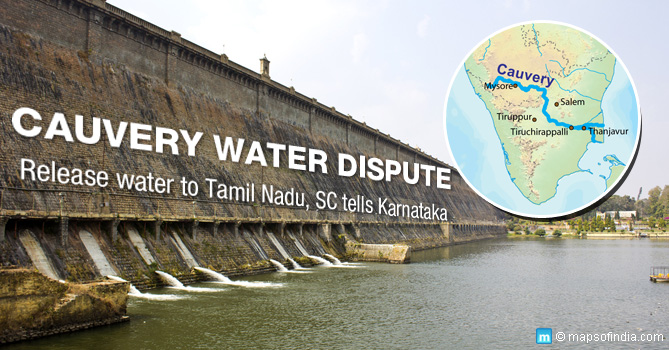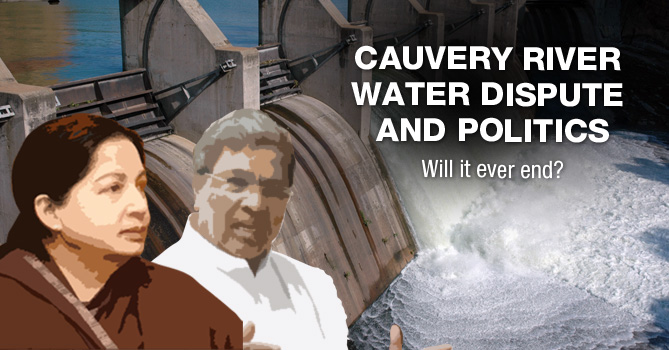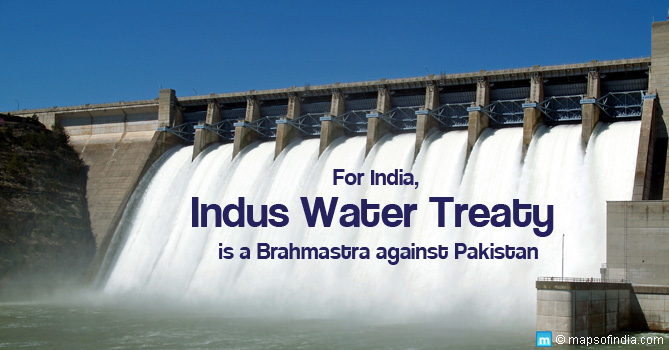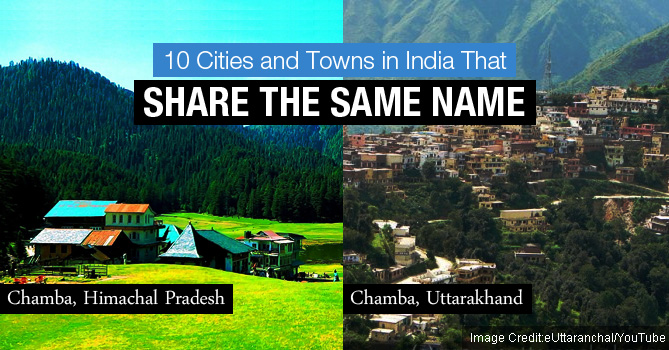Cauvery (Kaveri) Water Dispute
On 5th September, in the latest development in Cauvery water controversy, Supreme Court asked Karnataka to release water to Tamil Nadu. It has asked the state administration in Karnataka to provide its southern neighbours 15,000 cusec water over the next 10 days, so that the state is able to satisfy the demands of its farmers for growing summer crops this year.

Tamil Nadu has already asserted that between the months of June and August it has suffered water deficit to the tune of 60 thousand million cubic feet (tmcft). A Supreme Court bench comprising Justices Uday Umesh Lalit and Dipak Mishra has also asked Supervisory Committee to look into the issue. In its ruling the judicial bench has also observed that without the water the samba crops in Tamil Nadu would be adversely affected.
A statewide ‘bandh’ by the Cauvery Horata Samiti
Soon after Supreme Court’s September 5 verdict of releasing 15,000 cusecs of water to Tamil Nadu, the Cauvery Horata Samiti, an organisation that has been at the forefront of the dispute in Karnataka, called for a statewide ‘bandh’. The day was marked by violent protests in different parts of the state and the same affected schools, colleges, government offices and public transport facilities in Mandya.
In a bid to ease out the violence prevalent across Karnataka, the apex court asked the state government to release just 12,000 cusecs to Tamil Nadu, on a daily basis until 20 September 2016.
Karnataka Government imposed Section 144 in the state
Amid confusion regarding the imposition of Section 144 in the state of Karnataka, the Bengaluru Police confirmed clamping the Section 144 in Bengaluru till 14 September 2016.
Even after imposition of Section 144 in Karnataka, protests continued across the state with vehicles been set on fire and public property been vandalised in Bengaluru. With curfew been imposed in 16 police station limits, violent sparked off after the Supreme Court rejected Karnataka’s plea to temporarily stop the release of Cauvery river water to Tamil Nadu.
A man was killed and another one injured during an incident where a mob tried attacking a patrol at Hegganahalli in Bengaluru. With more than 200 arrests recorded till date, rioters continued attacking 30 buses with Tamil Nadu licence plates, positioned at a depot in the Bengaluru city. Additionally, even a woman television journalist and her cameraman were punched and assaulted during the violence in Bengaluru.
Paramilitary forces deployed in Karnataka
As an initiative to tackle the violence, the Centre didn’t delay in deploying 1,000 personnel of the special anti-riot paramilitary force RAF to Karnataka. The contingents were in-charge of assisting state police in all the violence-prone areas of Karnataka. Officials also announced deployment of some contingents in Tamil Nadu.
What is Cauvery Water Dispute?
Sharing the waters of the Cauvery River has been the main reason behind the serious conflict between Karnataka and Tamil Nadu. The former India state claims that it doesn’t receive its due share of water from the Cauvery River. Plus, it has also demanded for a renegotiated settlement that must be based on “equitable sharing of the waters”. In retaliation to this, Tamil Nadu has denied making any kind of changes to the existing pattern of using the river’s water as doing the same is believed to affect the livelihood of farmers residing in the state.
History of the dispute
Cauvery River water dispute dates back to 1892 when an agreement was filed between Mysore and Madras Presidency for the conciliation of the issue. Initially, the dispute was between Tamil Nadu and Karnataka, but later Puducherry and Kerala also asked for their share of water from the Cauvery River. Later, a tribunal (constituted by the Government of India) delivered a verdict, wherein it allocated 419 billion ft. of water annually to Tamil Nadu, 270 billion ft. to Karnataka, 30 billion ft. to Kerala and 7 billion ft. to Puducherry. However, the dispute seems to exist with all the four states holding their decision of filing review petitions for the renegotiation of order.
Birth of dispute between Karnataka and Tamil Nadu
With Karnataka and Tamil Nadu receiving lesser rainfall than the normal during the monsoon season in 2016, the issue of sharing the Cauvery river water has made the situation volatile between the two states. Things became worse after Supreme Court directed Karnataka state government to release 15,000 causecs of Cauvery river water to Tamil Nadu for 10 days as an attempt to save the samba crops. Activists and farmers of Cauvery Horata Samiti in Karnataka blocked roads in Shrirangapattana taluk of Mandya to protest against Supreme Court’s verdict.
Response times
The apex judicial body of India has also given 3 days’ time to Tamil Nadu state to express its grievance to the Supervisory Committee. The final order, in this case, is expected to come from Cauvery Water Disputes Tribunal (CWDT). The same period has also been given to Karnataka to issue its response to Tamil Nadu’s plea. Supervisory Committee itself has been given the time of 4-10 days to look into the matter and provide necessary directions.
In fact, Tamil Nadu has also been asked to release water to Puducherry as part of the interim agreement between both the regions. The case is expected to be heard again on 16th September.
Emotional appeal
On 2nd September — in what can be regarded as an emotional appeal — the Supreme Court had asked Karnataka to “live and let live”, perhaps in relation to sharing of waters between the two states. This happened after the Chief Minister of Karnataka had said that Tamil Nadu will not receive a single drop of water from it, and the latter had brought it to the notice of the highest judicial authority in India.
Saving the crops
In a plea made recently, Tamil Nadu had asked for Karnataka to be directed to release Cauvery’s water amounting to 50.52 tmcft, so that it could save seasonal samba crops spread over 40,000 acres. In its reply, Karnataka had stated that it was itself running short of 80 tmc feet in four of its reservoirs. FS Nariman, a senior lawyer representing the state, had said that Karnataka was itself suffering from inadequate rainfall and as such releasing water to Tamil Nadu had become quite a difficult proposition.
Role of CWDT
Nariman had also said that CWDT had provided no substitute to Cauvery water for months when the rainfall was less than necessary. Tamil Nadu had previously pleaded that Cauvery Management Board be set up so that CWDT award could be implemented. However, Supreme Court had refused to provide an emergency hearing to this issue. In 2013, Indian Government, on the basis of directions provided by the Supreme Court, had provided notifications on how waters of Cauvery would be finally distributed between the regions Karnataka, Tamil Nadu, Kerala, and Puducherry.
CWDT had itself stated that a board or authority be set up for the management of Cauvery waters, so that the apex court’s order could be implemented properly. This was to be done much in the same way as Bhakra Beas Management Board. The stated board, once constituted, would set up a water regulation committee that would help it. In a unanimous decision the tribunal, set up in 1990 by Indian Government to look into the issue and doing so for 16 years, had decided in 2007 that Cauvery Basin had 740 tmcft of water at the site in Lower Coleroon Anicut. 14 tmcft of this water was to be used so that it could seep into the sea and fulfil the purpose of protecting the nearby environment.
The final award of water
As part of the final decision, 419 tmcft of water was allotted to Tamil Nadu, followed by 270 tmcft to Karnataka. Kerala (30 tmcft) and Puducherry (7 tmcft) brought up the rear. The states, however, did not agree to this and opted to file review petitions where they sought clarification of the order and also asked for the amount to be negotiated again.
The root cause of the problem
Cauvery water dispute happens to be one of the most well-known of its kind in India. It has been a serious bone of contention between Tamil Nadu and Karnataka over the last many years . The crisis can be traced back to two agreements signed between the princely state of Mysore and Madras Presidency back in 1892 and 1924. Cauvery drains an entire area of 802 km. In Tamil Nadu, it occupies a basin area of 44,000 km2, and 32,000 km2 in Karnataka.
Karnataka opines that the said agreements were made highly to favour Madras Presidency, as a result of which it never gets its fair share of water. Ever since it has been calling for a better agreement that will ensure that water is shared equitably. However, Tamil Nadu also has its problems in the regard.
It is heavily dependent on the river and as such it has developed nearly 3 lakh acres of land based on how it is habituated to using the river’s waters. It argues that if this arrangement is disturbed even to the smallest extent, it can have a detrimental effect on the incomes and lives of millions of farmers in the state. For years now, the two states have attempted to negotiate but to no avail thus far.
Read More:
Cauvery River Map
Rivers in India
Is water mismanagement behind the Cauvery River water dispute?
Karnataka River Map
Tamil Nadu River Map
Mahadayi Water Dispute






